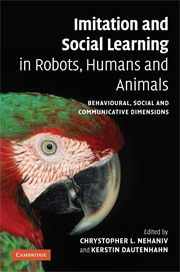 Imitation and Social Learning in Robots, Humans and Animals
Imitation and Social Learning in Robots, Humans and Animals Book contents
- Frontmatter
- Contents
- List of plates
- List of figures
- List of tables
- List of contributors
- Introduction: the constructive interdisciplinary viewpoint for understanding mechanisms and models of imitation and social learning
- Part I Correspondence problems and mechanisms
- Part II Mirroring and ‘mind-reading’
- Part III What to imitate?
- Part IV Development and embodiment
- Part V Synchrony and turn-taking as communicative mechanisms
- Part VI Why imitate? – Motivations
- Part VII Social feedback
- Part VIII The ecological context
- Index
- Plate section
Part IV - Development and embodiment
Published online by Cambridge University Press: 10 December 2009
- Frontmatter
- Contents
- List of plates
- List of figures
- List of tables
- List of contributors
- Introduction: the constructive interdisciplinary viewpoint for understanding mechanisms and models of imitation and social learning
- Part I Correspondence problems and mechanisms
- Part II Mirroring and ‘mind-reading’
- Part III What to imitate?
- Part IV Development and embodiment
- Part V Synchrony and turn-taking as communicative mechanisms
- Part VI Why imitate? – Motivations
- Part VII Social feedback
- Part VIII The ecological context
- Index
- Plate section
Summary
Imitation plays an important part in social and cognitive development of humans and possibly could also do so for artifacts (Dautenhahn, 1995). This section is concerned with issues of embodiment and development of imitative capabilities in infants, people with autistic spectrum disorder and robots. The first chapter links, in a developmental sense, the imitation of body movements to learning about the meaning of actions and mental states of others, a prerequisite for the transmission and communication of mental states (‘mind-reading’). Studying imitation skills in people with autistic spectrum disorders, who show impairments in social understanding and imitation, is hoped to shed light on the role of imitation in social cognition. The second chapter discusses a four-stage model of imitative abilities in infants in the context of a formal framework aimed at implementing robotic imitators. The stages range through learning about controlling one's own body, to imitation of body movements and actions on objects, to learning about inferring others' intentions and goals. The final chapter addresses the correspondence problem that robotic imitators need to solve when mapping observed behaviour (of possibly dissimilarly embodied models) to their own behaviours. In simulation studies conditions of synchrony, perceptual and proprioceptive matching, as well as cultural transmission of skills are investigated. Moreover, the bodies of the imitators may also grow and change, and the effect of this is studied. The three chapters range from developmental studies with humans to interdisciplinary work on robotic imitators inspired by developmental models and approaches.
- Type
- Chapter
- Information
- Imitation and Social Learning in Robots, Humans and AnimalsBehavioural, Social and Communicative Dimensions, pp. 195 - 198Publisher: Cambridge University PressPrint publication year: 2007


